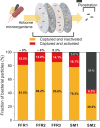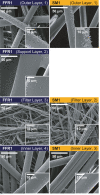Evaluation of survival rates of airborne microorganisms on the filter layers of commercial face masks
- PMID: 33682971
- PMCID: PMC8251341
- DOI: 10.1111/ina.12816
Evaluation of survival rates of airborne microorganisms on the filter layers of commercial face masks
Abstract
After the WHO designated COVID-19 a global pandemic, face masks have become a precious commodity worldwide. However, uncertainty remains around several details regarding face masks, including the potential for transmission of bioaerosols depending on the type of mask and secondary spread by face masks. Thus, understanding the interplay between face mask structure and harmful bioaerosols is essential for protecting public health. Here, we evaluated the microbial survival rate at each layer of commercial of filtering facepiece respirators (FFRs) and surgical masks (SMs) using bacterial bioaerosols. The penetration efficiency of bacterial particles for FFRs was lower than that for SMs; however, the microbial survival rate for all tested masks was >13%, regardless of filtration performance. Most bacterial particles survived in the filter layer (44%-77%) (e.g., the core filtering layer); the outer layer also exhibited significant survival rates (18%-29%). Most notably, survival rates were determined for the inner layers (<1% for FFRs, 3%-16% for SMs), which are in contact with the respiratory tract. Our comparisons of the permeability and survival rate of bioaerosols in each layer will contribute to bioaerosol-face mask research, while also providing information to facilitate the establishment of a mask-reuse protocol.
Keywords: airborne microorganisms; bioaerosol; face mask; facepiece respirator; filter layer.
© 2021 John Wiley & Sons A/S. Published by John Wiley & Sons Ltd.
Conflict of interest statement
The authors declare no competing interests.
Figures








Similar articles
-
Evaluation of filtration characteristics and microbial recovery rates of commercial filtering facepiece respirators against airborne bacterial particles.Sci Total Environ. 2019 Sep 10;682:729-736. doi: 10.1016/j.scitotenv.2019.05.153. Epub 2019 May 16. Sci Total Environ. 2019. PMID: 31141754
-
Comparison of Fit for Sealed and Loose-Fitting Surgical Masks and N95 Filtering Facepiece Respirators.Ann Work Expo Health. 2021 May 3;65(4):463-474. doi: 10.1093/annweh/wxaa125. Ann Work Expo Health. 2021. PMID: 33458738 Free PMC article.
-
A quantitative assessment of the total inward leakage of NaCl aerosol representing submicron-size bioaerosol through N95 filtering facepiece respirators and surgical masks.J Occup Environ Hyg. 2014;11(6):388-96. doi: 10.1080/15459624.2013.866715. J Occup Environ Hyg. 2014. PMID: 24275016 Free PMC article.
-
Effectiveness of face masks for the population.Ann Ig. 2021 Jul-Aug;33(4):347-359. doi: 10.7416/ai.2020.2390. Epub 2020 Dec 3. Ann Ig. 2021. PMID: 33258868 Review.
-
Role of respirators in controlling the spread of novel coronavirus (COVID-19) amongst dental healthcare providers: a review.Int Endod J. 2020 Aug;53(8):1062-1067. doi: 10.1111/iej.13313. Epub 2020 May 29. Int Endod J. 2020. PMID: 32357257 Free PMC article. Review.
Cited by
-
Comparison of bacterial filtration efficiency vs. particle filtration efficiency to assess the performance of non-medical face masks.Sci Rep. 2022 Jan 24;12(1):1188. doi: 10.1038/s41598-022-05245-4. Sci Rep. 2022. PMID: 35075199 Free PMC article.
-
Disposable surgical masks affect the decomposition of Zostera muelleri.Mar Pollut Bull. 2023 Mar;188:114695. doi: 10.1016/j.marpolbul.2023.114695. Epub 2023 Feb 10. Mar Pollut Bull. 2023. PMID: 36774916 Free PMC article.
References
-
- WHO . Coronavirus disease (COVID‐19) advice for the public: when and how to use masks. 2020.
-
- ASTM . F2101–01: Standard test method for evaluating the bacterial filtration efficiency (BFE) of medical face mask materials, using a biological aerosol of Staphylococcus aureus . American Society for Testing and Materials. 2001.
Publication types
MeSH terms
Substances
Grants and funding
LinkOut - more resources
Full Text Sources
Other Literature Sources

